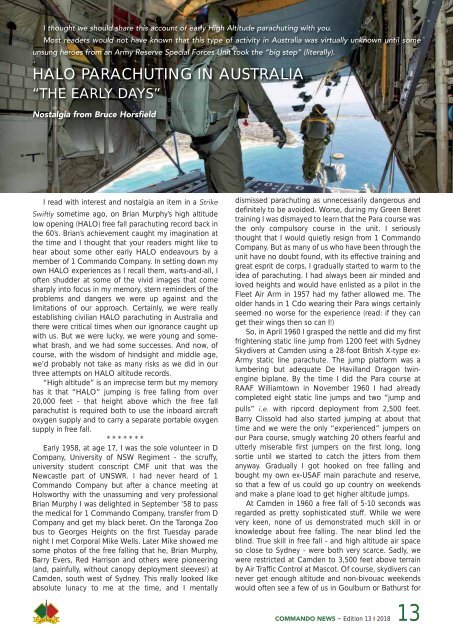You also want an ePaper? Increase the reach of your titles
YUMPU automatically turns print PDFs into web optimized ePapers that Google loves.
I thought we should share this account of early High Altitude parachuting with you.<br />
Most readers would not have known that this type of activity in Australia was virtually unknown until some<br />
unsung heroes from an Army Reserve Special Forces Unit took the “big step” (literally).<br />
HALO PARACHUTING IN AUSTRALIA<br />
“THE EARLY DAYS”<br />
Nostalgia from Bruce Horsfield<br />
I read with interest and nostalgia an item in a Strike<br />
Swiftly sometime ago, on Brian Murphy’s high altitude<br />
low opening (HALO) free fall parachuting record back in<br />
the 60’s. Brian’s achievement caught my imagination at<br />
the time and I thought that your readers might like to<br />
hear about some other early HALO endeavours by a<br />
member of 1 <strong>Commando</strong> Company. In setting down my<br />
own HALO experiences as I recall them, warts-and-all, I<br />
often shudder at some of the vivid images that come<br />
sharply into focus in my memory, stern reminders of the<br />
problems and dangers we were up against and the<br />
limitations of our approach. Certainly, we were really<br />
establishing civilian HALO parachuting in Australia and<br />
there were critical times when our ignorance caught up<br />
with us. But we were lucky, we were young and some -<br />
what brash, and we had some successes. And now, of<br />
course, with the wisdom of hindsight and middle age,<br />
we’d probably not take as many risks as we did in our<br />
three attempts on HALO altitude records.<br />
“High altitude” is an imprecise term but my memory<br />
has it that “HALO” jumping is free falling from over<br />
20,000 feet - that height above which the free fall<br />
parachutist is required both to use the inboard aircraft<br />
oxygen supply and to carry a separate portable oxygen<br />
supply in free fall.<br />
* * * * * * *<br />
Early 1958, at age 17, I was the sole volunteer in D<br />
Company, University of NSW Regiment - the scruffy,<br />
university student conscript CMF unit that was the<br />
Newcastle part of UNSWR. I had never heard of 1<br />
<strong>Commando</strong> Company but after a chance meeting at<br />
Holsworthy with the unassuming and very professional<br />
Brian Murphy I was delighted in September ‘58 to pass<br />
the medical for 1 <strong>Commando</strong> Company, transfer from D<br />
Company and get my black beret. On the Taronga Zoo<br />
bus to Georges Heights on the first Tuesday parade<br />
night I met Corporal Mike Wells. Later Mike showed me<br />
some photos of the free falling that he, Brian Murphy,<br />
Barry Evers, Red Harrison and others were pioneering<br />
(and, painfully, without canopy deployment sleeves!) at<br />
Camden, south west of Sydney. This really looked like<br />
absolute lunacy to me at the time, and I mentally<br />
dismissed parachuting as unnecessarily dangerous and<br />
definitely to be avoided. Worse, during my Green Beret<br />
training I was dismayed to learn that the Para course was<br />
the only compulsory course in the unit. I seriously<br />
thought that I would quietly resign from 1 <strong>Commando</strong><br />
Company. But as many of us who have been through the<br />
unit have no doubt found, with its effective training and<br />
great esprit de corps, I gradually started to warm to the<br />
idea of parachuting. I had always been air minded and<br />
loved heights and would have enlisted as a pilot in the<br />
Fleet Air Arm in 1957 had my father allowed me. The<br />
older hands in 1 Cdo wearing their Para wings cer tainly<br />
seemed no worse for the experience (read: if they can<br />
get their wings then so can I!)<br />
So, in April 1960 I grasped the nettle and did my first<br />
frightening static line jump from 1200 feet with Sydney<br />
Skydivers at Camden using a 28-foot British X-type ex-<br />
Army static line parachute. The jump platform was a<br />
lumbering but adequate De Havilland Dragon twinengine<br />
biplane. By the time I did the Para course at<br />
RAAF Williamtown in November 1960 I had already<br />
completed eight static line jumps and two “jump and<br />
pulls” i.e. with ripcord deployment from 2,500 feet.<br />
Barry Clissold had also started jumping at about that<br />
time and we were the only “experienced” jumpers on<br />
our Para course, smugly watching 20 others fearful and<br />
utterly miserable first jumpers on the first long, long<br />
sortie until we started to catch the jitters from them<br />
anyway. Gradually I got hooked on free falling and<br />
bought my own ex-USAF main parachute and reserve,<br />
so that a few of us could go up country on weekends<br />
and make a plane load to get higher altitude jumps.<br />
At Camden in 1960 a free fall of 5-10 seconds was<br />
regarded as pretty sophisticated stuff. While we were<br />
very keen, none of us demonstrated much skill in or<br />
knowledge about free falling. The near blind led the<br />
blind. True skill in free fall - and high altitude air space<br />
so close to Sydney - were both very scarce. Sadly, we<br />
were restricted at Camden to 3,500 feet above terrain<br />
by Air Traffic Control at Mascot. Of course, skydivers can<br />
never get enough altitude and non-bivouac week ends<br />
would often see a few of us in Goulburn or Bathurst for<br />
COMMANDO NEWS ~ Edition <strong>13</strong> I <strong>2018</strong> <strong>13</strong>

















